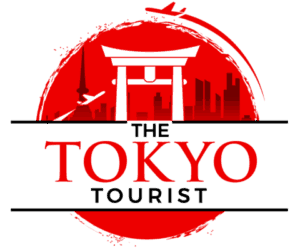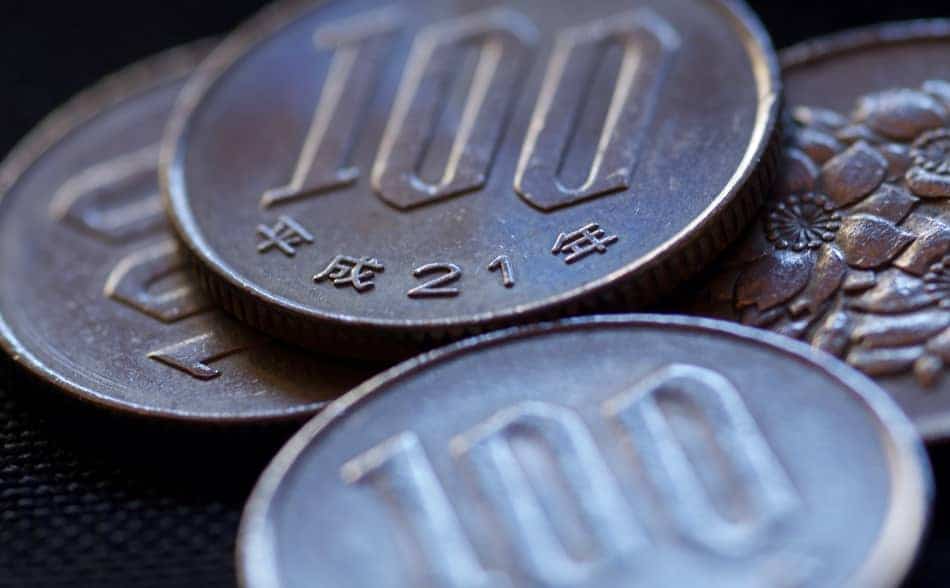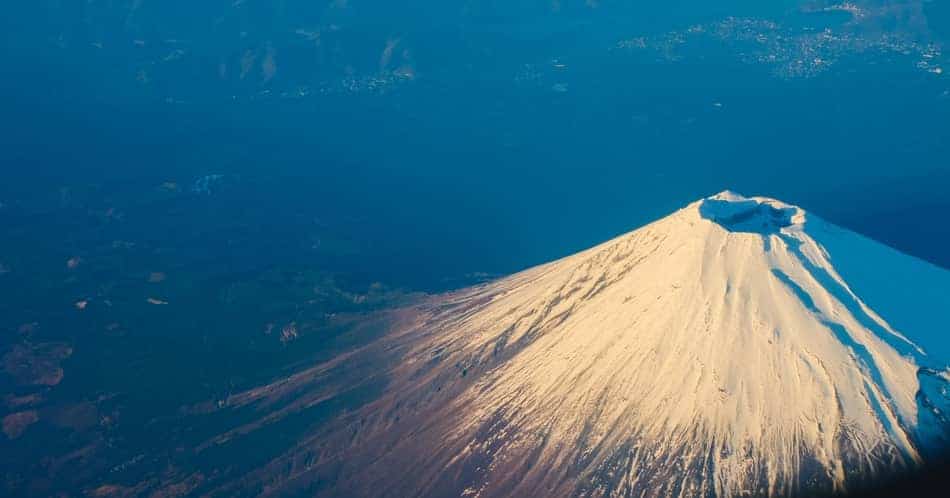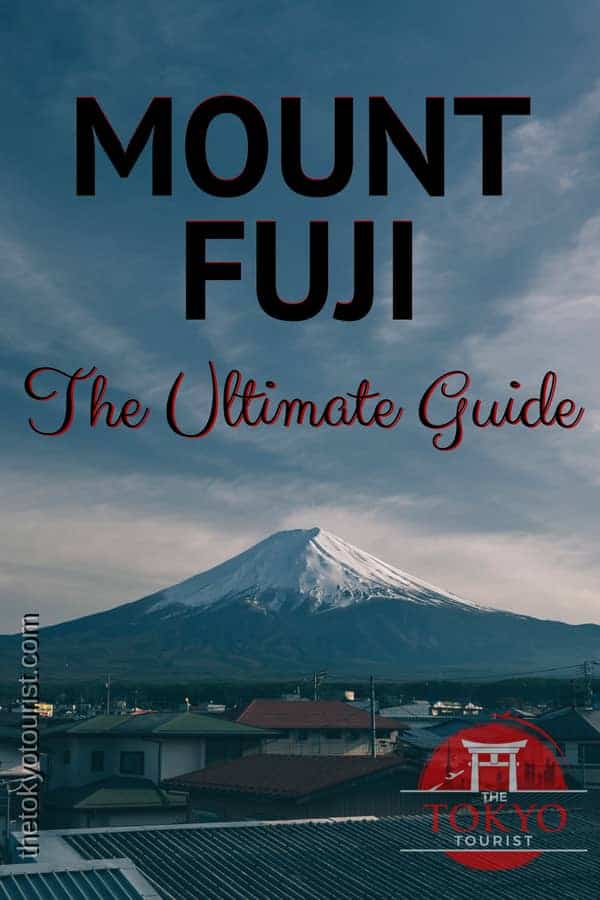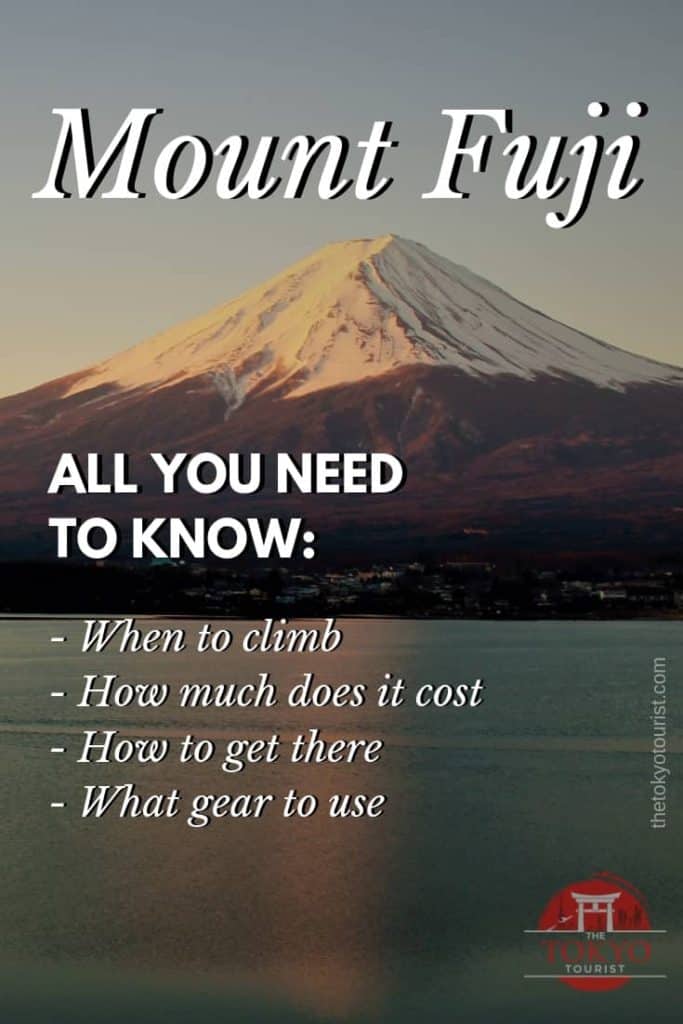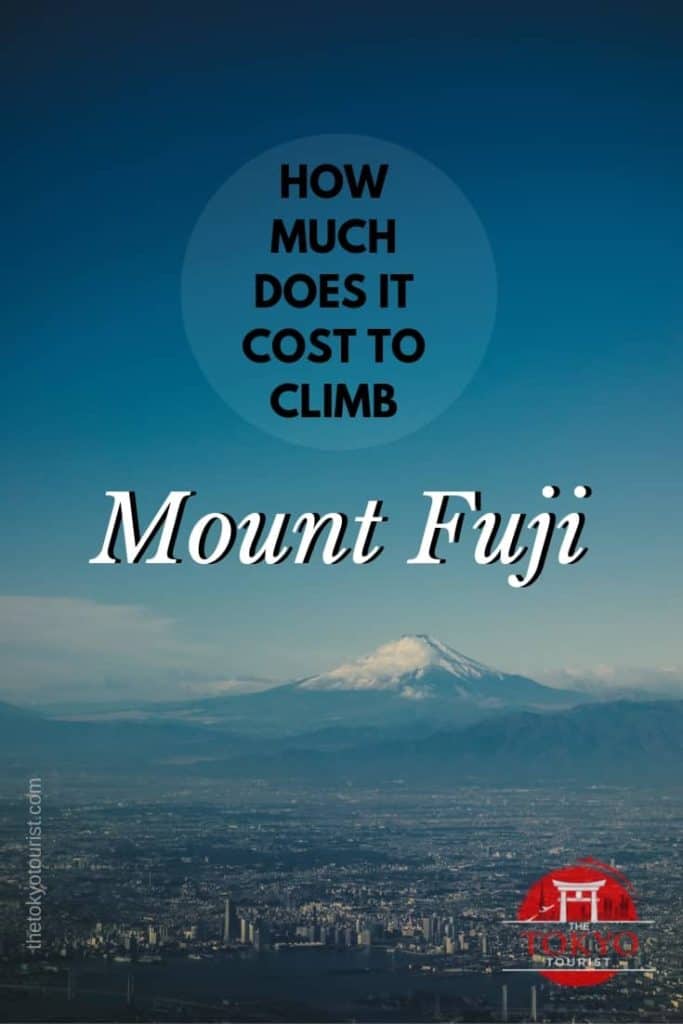Deprecated: mb_convert_encoding(): Handling HTML entities via mbstring is deprecated; use htmlspecialchars, htmlentities, or mb_encode_numericentity/mb_decode_numericentity instead in /home2/thetoky7/public_html/wp-content/themes/acabado/functions.php on line 2119
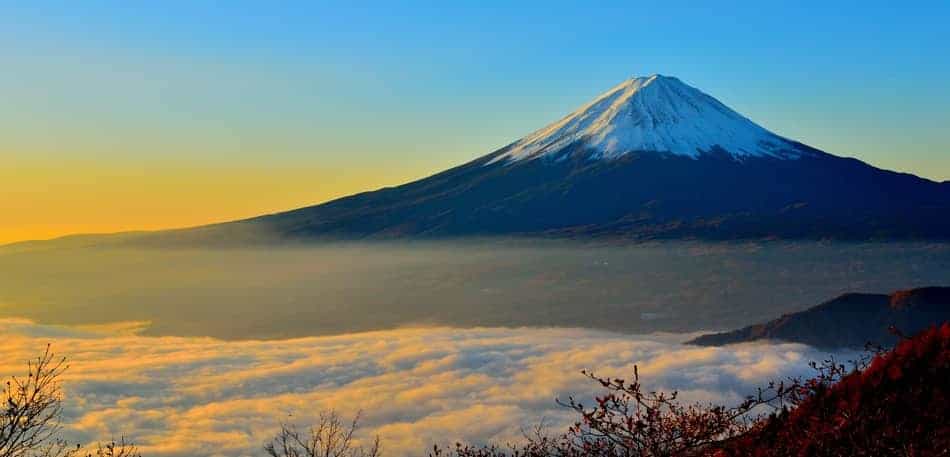
So you want to climb Mount Fuji? This guide is for people with some or no experience with climbing and long hikes. So if you’re an average person with lots of questions about Mount Fuji and how to climb the sucker, you’ve come to the right place! This is the only resource you’ll need to get all your questions answered.
In this guide, I’ll run you through how hard the climb is, how long it takes, when you should climb, how you should prepare, what you have to bring, how to get to the mountain, what it will cost and not least: How not to make a fool out of yourself!
Warning: Long and thorough article!
Packing list for Mount Fuji:
Check out Hiking Gear – Clothing (opens in a new tab.)
Check out Recommended Equipment (opens in a new tab.)
Check out the list of stuff you don’t even know you need (opens in a new tab.)
Drawing on My Own Experience and A LOT of Research
Just so you have a baseline: I’m a male, average physique, in my 30’s. Not an avid climber but I’ve been on some long hikes. I’ve also bBLeen on some other mountain tops but none as high as the Mount Fuji summit.
Have you actually climbed Mount Fuji or are you just full of sh*t?
Yes, I have! I climbed Mount Fuji in July 2011. This article is based partly on my own experience, partly on the HUGE amount of research I did before my own climb and of course on brand new research so I can provide you with all the latest information.
This guide to climbing Mount Fuji will mostly be about how to prep, what to expect, what to bring and so on, but first let’s have a quick look at the mountain itself.
Quick Facts about Mount Fuji
Mount Fuji – or Fujisan as it’s called in Japan – is the most visited mountain in the world. It is considered to be a sacred mountain for followers of the Shinto religion. There are hundreds of small shrines around the foot of the mountain. Ever since the 15th century, the climb has been considered to be an important pilgrimage for the followers of Shintoism.
Before we get going here are some geographical facts about Mount Fuji mixed in with a few specific climbing facts.
[table id=3 /]
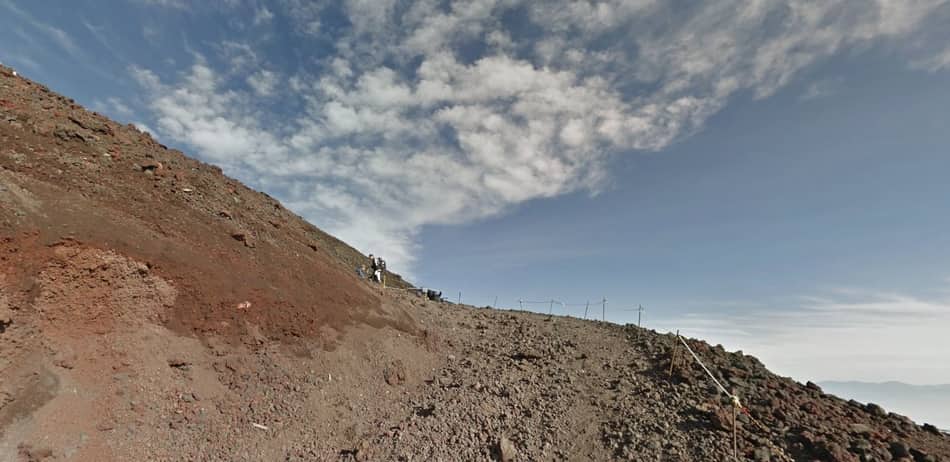
How Long Does it Take to Climb Mount Fuji?
The quick and dirty answer is anything from 6-7 hours to 2+ days! It depends on where you start and which trail you follow. Mount Fuji has four different trails varying in length and thus the time it takes to follow it all the way to the summit. The number of mountain and service huts differ as well, and two of the trails have no first aid stations. Some trails are considered to be for “beginners,” and some are seen as harder and for more experienced climbers.
All the different trails have stations along the routes, all the way from 1st Station to 10th Station (the summit). All the trails’ 5th stations are accessible by motor vehicles, and that’s why all the trails’ natural starting points (for most climbers) are at the 5th station. If you want to start your hike at the 1st station, you’ll have to walk for hours on hours on roads. This guide will not be covering that approach.
By the way: The really hardcore way to climb Mount Fuji is to start off from sea level. It will take you more than two days, and that’s too much for me! But if you’re into that sort of thing, you can check out From sea to summit.
Let’s have a look at the different trails and find the one best suited for you.
Yoshida Trail
This trail is by far the most popular trail, and 60% of climbers ascend the mountain using this route. It’s also the trail I followed when I climbed Mount Fuji. Since it’s the most popular, it’s obviously also the most crowded trail. It’s popular because it’s easily accessible from Tokyo, one of the easier trails and the trail with the most mountain huts on the ascent.
This trail starts from the north side of Mount Fuji from a station called Fuji-Subaru Line 5th Station. You’ll soon make your way to the east side of the mountain, so this is a good trail if you want to see the sunrise from the mountainside.
Trail Head: Fuji Subaru Line 5th Station
Altitude of Trail Head: 7 545 feet / 2 300 meters
Hiking Distance: 6.8 km
Subashiri Trail
The forest zone on this trail extends up higher than the other trails. So you’ll be walking in a forest until about an altitude of 8 800 feet (2 700 meters). Subashiri Trail meets Yoshida Trail at the 8th Station which can lead to some congestion.
The descent from this trail is special. From the 7th Station and down to the 5th Station there are sand slopes. Many people decide to take a sandy run downhill.
Trail Head: Subashiri Trail 5th Station
Altitude of Trail Head: 6 560 feet / 2 000 meters
Hiking Distance: 6.8 km
Gotemba Trail
I feel my muscles aching from just writing about this trail. It has the lowest starting point thus making it by far the trail with the longest hiking distance and the highest elevation to climb. It starts off south-east of Mount Fuji at only 1 450 meters above sea level. From here you’ll have to climb an elevation of 7 750 feet (2 326 meters) with a hiking distance of 4.8 miles (7.8 km).
The slope is gentle, so if you cope well with large altitude differences and have really good legs, this trail can be the right one for you. Gotemba Trail is the least crowded of the four trails, and it’s also the trail with the fewest mountain huts.
Trail Head: Gotemba Trail New 5th Station
Altitude of Trail Head: 4 760 feet / 1 450 meters
Hiking Distance: 7.8 km
Fujinomiya Trail
This is the trail that starts off closest to the summit. It’s straight south of Mount Fuji, so if you’re in the middle of the mountainside during the sunrise, you will not see it. It’s the second most popular trail after Yoshida Trail, but it’s considered to be harder to climb since the slope is steep and rocky.
The trail for ascent is exactly the same as the trail for the descent. This means you’ll have to make way for people going the opposite way of yourself.
Trail Head: Fujinomiya Trail 5th Station
Altitude of Trail Head: 7 875 feet / 2 400 meters
Hiking Distance: 5 km
Trail Comparison Chart! Let’s make it easy
[table id=4 responsive=scroll /]
Who Can Climb Mount Fuji?
I’ve seen different Mount Fuji articles say that “everybody can climb Mount Fuji!” Well, that’s a blatant lie. And the reason they’re feeding you this lie is probably because they’re trying to sell you something like a guided tour or transport. The more people attempting the climb (no matter if they fail or succeed) = More $$$ (or ¥¥¥ in this case!) According to numbers from a tour guide I know, about 50% of people who try to climb Mount Fuji don’t make it to the summit.
You don’t need advanced climbing skills to climb Mount Fuji, but there are some steep parts where you’ll need to use your hands. Towards the end of the all the four trails (after the 9th station), it gets quite steep. Here you’ll have to take long steps from rock to rock. Also, when it rains the rocks can get very slippery. Slippery rocks with strong gusts of wind can make it scary. However, there are warning signs wherever you need to pay extra attention or be extra careful.
The trails are well marked, so you don’t have to navigate. It’s possible to hire a guide, but in my opinion, you don’t need it. You also feel more like an explorer if you (and your partner/group) climb the mountain “alone”!
So why can’t everybody climb Mount Fuji? Wheather or not you can climb Mount Fuji depends on your physical fitness and your mental toughness.
Physical Fitness
You have to be able to walk for hours on hours in rough terrain. The ascent and descent of Mount Fuji usually take over 10 hours of walking time, depending on which trail you follow. BUT, the good thing is: You can always take your time. Let’s say you follow the Yoshida Trail where the ascent will usually take around 6 hours. If that’s too fast for you, just take more breaks and set a slower pace, and climb it in 8 hours. Don’t push yourself beyond your limits.
If you’re currently not in great shape and think the climb is going to be a struggle, just plan to use some more time on the ascent. But prepare your ego to suffer when those 70-year-old Japanese grannies run past you up the mountainside! But seriously, if you’re of somewhat close to normal physique, I think you can do it! Just take your time and prepare well mentally. I have more on the physical preparation needed later in the article.
Mental Toughness
Unless you’re unusually fit you WILL get tired. Your muscles WILL start aching. Negative thoughts might make their way into your brain. You need to be able to power through sore muscles and negative feelings. And if you prepare right and have the right gear, you’ll probably be fine. If you’re doing the climb in a group, you can help and encourage each other.
Are You Afraid of Heights?
Unless you have an extreme case of acrophobia, you should be fine! There are no sections with cliffs. It’s more like going up a loooong hill. So, if you’re comfortable climbing long hills, you should be fine climbing Mount Fuji.
Can Even KIDS Climb Mount Fuji?
Before my climb, I did a lot of research. During that research, I read that some kids actually do climb Mount Fuji. Even though I had read this, it was still a bit of a shock to see kids as young as 9-10 years old tagging along with their parents up the mountainside. Considering you’ll be walking for about 10 hours in very thin air, those kids really impressed me! Would I take my own 10-year-old kid on a hike up Mount Fuji? Probably not, but that’s just me. So, kids can climb the mountain but they also need to be physically fit and mentally strong.
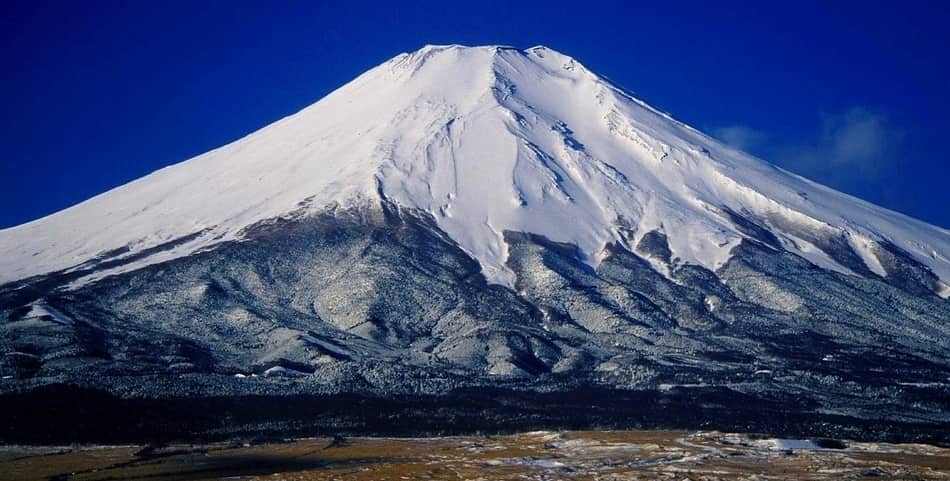
Mount Fuji Climbing Season
There’s the “climbing season,” and there’s the “OFFICAL climbing season.” In theory, you can climb Mount Fuji all year long. But if you don’t have a lot of hiking experience in high altitudes, it’s strongly advised to only climb Mount Fuji during the official climbing season. The weather is more forgiving, and the various service huts are open. This article isn’t written for climbing experts so when I talk about the “climbing season” I’m only talking about the official and safe one.
The official climbing season for Mount Fuji runs from July to early September. The dates vary a bit, and it’s based on the amount of snow left in the mountain. During the climbing season, the mountain huts are operating, and access by public transport is easy.
Usually, Yoshida Trail opens a few weeks before Subashiri Trail, Gotemba Trail and, Fujinomiya Trail. Be sure to check the official Mount Fuji site for fresh information.
What Kind of Weather Can You Expect?
To be honest, the weather can potentially ruin your hike. Especially if you don’t have the right equipment. Even during the official climbing season (July 1 – September 10), the temperatures can get below freezing. If you combine icy rain from all directions at once with extremely strong winds, you’ll have a difficult situation on your hands. Thankfully it doesn’t happen that often. Yes, it can get wet, windy and cold, but if you prepared well and have the right gear, you can power through it. Let’s have a quick look at some of the averages you can expect.
Basically, the weather gets more extreme the higher you get. I’m giving you averages from the summit.
Strong Winds? How Strong Winds?
The Mount Fuji summit is known for its strong winds. The average annual wind speed is 25 mph (40 km/h). August is considered the month with the calmest winds, and even then the average wind speed is 20 mph (32 km/h). But remember! These are averages. You can get lucky and climb Mount Fuji with hardly any wind at all. Or you can get unlucky and get winds reaching 60 mph (100 km/h).
OR you can get EXTREMELY UNLUCKY. Like that day back in 1966. On September 25, 1966, there were recorded wind speeds of 203 mph (328 km/h)! That’s 300 feet (91 meters) per second. Better hold on to your hat!
What Temperatures Can I Expect During the Climb?
It’s a beautiful day; It’s warm, the sun is shining, and it’s not a cloud in the sky. The temperature in the flatlands surrounding Mount Fuji is 86°F (30°C). Even in good weather on a warm day like this, it’s likely to be around 60°F (15.5°C) at Fuji-Subaru Line 5th Station (7 545 feet / 2 300 meters). And the higher you’ll climb the colder it will get.
The average mean temperature is below freezing most months, except in the summer (June, July, August and September). Study the chart below so you can prepare for what to expect. But remember, this is the actual temperature and not what the temperature FEELS LIKE. A rule of thumb is:
- For every 3.2 feet of wind per second, the temperature feels 1.8°F colder
- For every 1 meter of wind per second, the temperature feels 1°C colder
An example:
- 41°F will feel like 23°F with wind speeds of 32.8 feet/s
- 5°C will feel like -5°C with wind speeds of 10m/s

Preparation before the Climb
By failing to prepare, you are preparing to fail. One would think it’s common sense to prepare well for big undertakings like this. But I’ve seen first hand that that’s unfortunately not the case. In my opinion, you need to prepare in three different ways.
Body
Not everybody can climb Mount Fuji! It’s not as easy as some blogs are saying! Many of us haven’t walked for 5 hours straight in our lives. Most of us haven’t been above 6 500 feet (2000 meters) and felt how the thin air (air with low amounts of oxygen) affects the body. Many of us have never scaled anything more significant than a puny hill. And by the way, that was back when we were 12 years old!
The Mount Fuji hike can easily take you 10 hours, and if you reach the summit, you’ll be at 12 389 feet (3 776 meters). AND you’ll be doing it with gear and with a backpack.
So how do you physically prepare? There’s no “one size fits all” when it comes to physical preparation. People have widely different starting points, so the following advice is for, how should I say it? Those of us who enjoy the couch just as much as we enjoy nature and long hikes!
In my opinion, the best way to prepare for long hikes is to go on some long hikes. Preferably in the hiking boots you’ll be using when you climb Mount Fuji. This is also a perfect way to break in new boots if you bought them especially for this trip!
Practice Hikes
About three weeks before your Mount Fuji climb you should start going on some hikes. Start out with 1-2 hour ones and try to seek out some hills. Walking in flat and steep terrain are two completely different things. When you get a couple of 1-2 hour hikes under your belt, you should try to get in at least one 3-4 hour long hike. If the 3-4 hour one is hard for you, Mount Fuji will probably be a living hell.
Also, be sure to check your feet carefully. You must avoid blisters at all costs.
If you completed the 3-4 hour hike and didn’t feel like killing yourself, I bet that you’ll be able to climb Japan’s tallest mountain, if you have the right gear and the right mindset!
Mind
If you’re not an experienced climber or in excellent health, at some point during the climb, you will get tired. It will get hard, and negative thought will enter your head. It’s important to know and prepare for this. If you’re reading this guide, you’ve already taken steps to prepare in the right way! Good for you!
You can find yourself in a situation where you’re so tired your calves are cramping up. And on top of that, you’re also cold and hungry. Take a minute to visualize yourself in the mountainside and try to imagine the feeling you’ll have when you’re EXHAUSTED and you’re only halfway. It’s not pleasant, is it?
This is the point where people turn back. This is the point where people take a conscious decision to FAIL their attempt to reach the summit. Why? Because their current situation seems worse than the value of the future payoff. Remember, why are you doing this? Not only will you be able to cross Mount Fuji off your bucket list but it’s also an achievement you’ll look back on with great pride for years to come. Try to tap into the mission accomplished feeling and use that energy to motivate your current self to help your future self!
And what exactly do you do when those negative thoughts start arising? Just acknowledge them and say to yourself: Hi, I’ve been expecting you! You are SO predictable coming here and trying to sabotage my climb. Anyway, nice seeing you, talk to you later. I have a job to do, and you’ll thank me when we reach the top.
Slow and steady wins the race. You can do it!
Gear
In my opinion, it’s totally irresponsible not to have at least some proper gear. You may think you’re the only one in jeopardy if you decide to climb Mount Fuji in converse and jeans without proper rainwear. But what do you think will happen when your feet are bleeding from walking in rocky terrain with bad shoes, and you’re close to hypothermia because you’re soaking wet in 41°F (5°C) weather with strong winds?
You’ll probably need to be taken care of by medical personnel and then carried down. Do not put yourself or others in danger by not using the right gear!
Gear and Equipment (Packing List for Mount Fuji)
I’ll break this one into two parts. One is the basic gear you need to reach the summit in a safe and “comfortable” way. (As comfortable one can be climbing a mountain!) Hiking boots, raingear, etc. The other part is a list of all the smart and useful stuff many people forget or don’t even think about.
Must-Have Gear (Need to Have)
In my humble opinion, this is the absolute minimum of what you need when you climb Mount Fuji. The weather can change extremely fast, so you need to be prepared for all sorts of scenarios. By the way, I don’t want to clutter this guide with a complete packing list, so I’ve made a page for it.
- A warm hat
- Windproof jacket
- Windproof and flexible pants
- Gloves
- Hiking boots
- Heavy socks
- A full raingear set (to use over your climbing gear in case of rain)
Check out the complete packing list here.
Recommended Equipment
Here you’ll find a list of non-clothing items you need when you Climb Mount Fuji.
- Backpack
- Hydration system
- Headlamp
- Face mask
- Gaiters
Check out this page for recommendations for equipment I’ve used myself and that works for me. Only good value options!
Things You Don’t Even Know You Need!
I remember thinking: Darn! Why didn’t I bring a hand towel to wipe my sweaty brow? If you don’t want to kick yourself half way up Mount Fuji because you didn’t bring something that would’ve been super useful you should check out this list. This is just a small taste of all the items you don’t know you should bring. Check out the complete list here.
- A small hand towel
- Pain Relievers
- Heat patch
- A plastic bag
- Flip flops
- Gum!
Don’t know what a heat patch is? Want the full list with an explanation for every item? Check out the complete list with details here.
How Much Does it Cost to Clumb Mount Fuji?
Climbing Mount Fuji is free! In theory, that is. There’s no admission fee, but you’ll probably need to spend money on some or all of these:
- Food and drink, which is quite expensive
- Gear
- Transport
- Accommodation (mountain hut)
- Oxygen cans (yep, some people use oxygen cans because the air is so thin)
- Equipment
- The use of bathrooms
- A donation to Fujisan Conservation Donation Campaign. This is voluntary. More info on the subject down below.
- A Mount Fuji walking stick and stamps for the stick
Bathroom Charge
You have to pay 200 yen every time you use the bathrooms on the mountain. The toilets have water, but the sinks don’t. Two important things:
Oxygen Cans
An oxygen can (not a tank) is 700 – 800 yen. It comes with a built-in mask and will give you around 35 puffs. It’s meant to combat fatigue and altitude sickness. But do you really need it? I’m not saying it’s useless, but it seems kind of gimmicky to me. If you feel exhausted by all means try it. But I wouldn’t buy a can before I really felt I needed it.
Fujisan Conservation Donation Campaign
Mount Fuji climbers are asked to donate to the Fujisan (Mount Fuji) Conservation Campaign. This is completely voluntary, but in my opinion, I think everybody should do it. They use the money for:
- Information centers
- Research for a more efficient sewage system for the toilets on the mountain
- First Aid Centers
- Climber safety (protective fences and automatic voice guidance)
- Installing signs with useful information
How Much Should I Donate?
The standard donation amount is 1 000 yen. But if you want to contribute more, you’re of course free to double and triple that amount. 🙂 In 2017 the average amount donated was 976 yen per donation.
Where Can I Donate?
There are three options.
- On-site
You can donate on-site at all the 5th station of all four trails. You can also donate at the Mizugatsuka Parking connected to Fujinomiya Trail and at Yoshida 6th station of the Yoshida Trail. - Convenience stores
7-Eleven, Family Mart, Lawson, Circle K, Sankus and Mini Stop. There are “multimedia terminals” located in the stores where you can buy a donation ticket worth 1 000. The multimedia terminals are only in Japanese. - Internet
You can donate over the internet. Unfortunately, the donation site is in Japanese only. You can find the original here (Japanese). If you want to see a Google translation you can check out this link (English).
The easiest thing is to bring some cash and hand it in at the 5th station on the trail you are following.
How much does Fujisan Conservation Donation Campaign Collect per year?
In 2017 the campaign got a total of 152 341 donations, and it amounted to close to 150 million yen. That’s $1.3m – 1.4m. This may sound like a lot, but when you think of the number of visitors in 2017 (approximately 270 000), it’s only $4.80 per person.
Mount Fuji Walking Stick
This one is interesting! From what I’ve read the correct Japanese word for these walking sticks are kongō-zue. The walkings sticks are based on the sticks the “holy men” called Yamabushi are using. I think it’s kind of gimmicky, but it’s still a nice souvenir, AND it’s actually somewhat useful, especially during your descent. As far as I know, you can get the sticks in three different sizes. So be sure you get one that fits well with your height!
Nice Souvenir, You Say?
Yes! For many people climbing Mount Fuji is a huge undertaking and for a lot of us, it’ll be the tallest point we’ll ever visit on planet Earth. Although you’ll always have your memories, it can be really special to have something physical to remember the trip by, like this loyal companion.
Not only will the walking stick help you climb the sacred mountain you can also make it more special by buying stamps at all the stations during your struggle to the top. The stamps are branded into the walking stick with a glowing hot branding iron. Very cool! For every stamp you get, the closer you are to the summit. Hanging on the wall this will be a true symbol of your accomplishment!
The Price of the Stick and the Stamps
How much does it all cost? If you buy your full-length walking stick at the 5th Station, it will cost you 1 000 yen. On the 6th Station, it’s 1 300 yen. Like everything else, the price keeps going up the further you get up in the mountainside! Each stamp is 200 yen, and you can get stamps on both the ascent and the descent. (I only bought them on the way up.) So if you want the full-length walking stick, with six stamps (5th, 6th, 7th, 8th, 9th, Summit), it will cost you 2 200 yen.
A Word of Warning: The Stick is Too Long For Most Luggage!
Think about it, will a 60″ (150 cm) stick fit in your suitcase? It didn’t fit in mine! If it doesn’t fit in your luggage, you have a few options:
- Some airlines will let you carry the stick onboard the plane. Be sure to check this in advance.
- It can be transported as checked luggage. If you’re only allowed one bag, the stick will count as excess baggage, and that can be really costly.
- You can ship it! When I shipped my stick 🙂 from Japan to Scandinavia, it cost me 2 200 yen. You can check the rates for shipments to your country here.
If you want to avoid the hassle with either checking or shipping your walking stick, you can always get a shorter one. They have smaller sticks (30″ / 75 cm), but they can’t be used as walking sticks unless you are tiny!
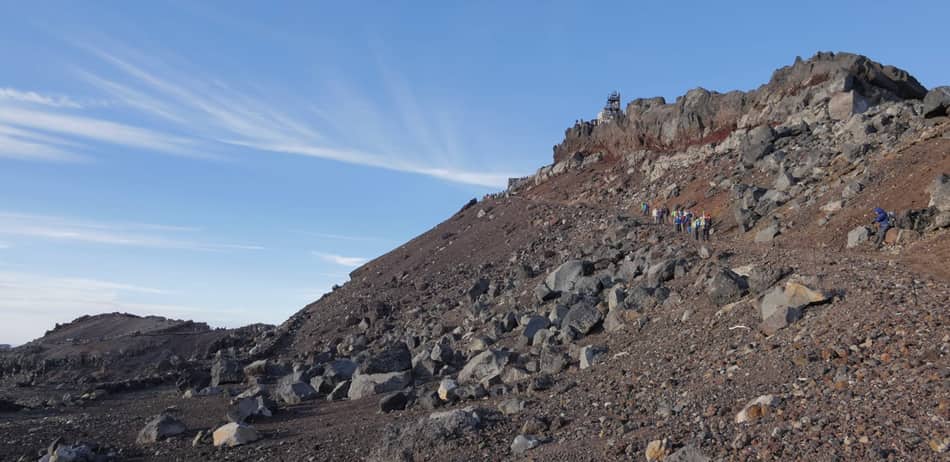
How You Can Make Climbing Mount Fuji Cheaper
When I climbed Mount Fuji, I thought of it as a once in a lifetime experience, and therefore I didn’t mind spending some money on it. I really wanted to scale the summit, and I wanted to be safe and comfortable doing it! But if you’re on a tight budget and dream of climbing Japan’s tallest mountain here are some tips that can make it a little cheaper. Although I wouldn’t recommend doing all of this I’m laying out the options so you can make an informed decision.
Food and Drink
You can bring your own food and drink. Buying it on Mount Fuji is far more expensive than buying it in normal shops. A small bottle of water can cost you 600-700 yen. You can bring a wide variety of stuff, but I would recommend energy-dense snacks: High-calorie and low weight. Trail mix or SmashPack are good alternatives. When it comes to water, just fill bottles and put them in your backpack. If you already have a CamelBak, be sure to bring it! It’s super useful. I have Camelbak Antidote Reservoir (100 oz / 3 liters). You can check out current prices at Amazon.
Pros: Depending on what kind of snacks you bring, it’s certainly cheaper!
Cons: Your water will be lukewarm, and you will not get hot food. Also, you have to carry more stuff up the mountain compared to if you buy it from the service huts as you go.
You Can Rent the Gear
I’m not going to lie. Gear can be quite expensive. If you already have the right gear, you’re all set. Just be sure you dodge the excess baggage fee on the plane! If you don’t have the right gear, you will have to rent it.
Although some people climb Mount Fuji in jeans and converse, you really shouldn’t do that. Do you know why? Who do you think fails to climb Mount Fuji? People in jeans and converse! You might luck out and avoid rain and bad weather, but do you really want to take that chance? Over 50% of Mount Fuji climbers experience rain during their climb. Ever worn wet jeans with temperatures of 40°F (5°C) in winds reaching 60 mph (100 km/h)?
You have quite a few options when it comes to renting gear for a Mount Fuji climb. I would recommend that you just google it to compare prices and equipment. I can give a shoutout to Yamarent though. I don’t have any affiliation, and I will not make a penny if you decide to use them. The reasons I do recommend them is because I have friends who have used their services and they had an OK experience. Yamarent has shops where you can try on gear, so you’ll hopefully get the size right. They have a shop for fitting in Shinjuku, Tokyo, and one in Kawaguchiko, the city right by Mount Fuji.
But it’s rather expensive. A full 12-piece set with raingear will cost you about 20 000 yen. With this package, you’ll be well prepared for whatever mother nature throws at you. Even though a rental fee of 20 000 yen is a lot to splash out, it a lot cheaper than to buy everything.
Good Stuff with Yamarent
- They have shops for fitting
- Free shipping in Japan if you order for more than 10 000 yen. You can try the gear on and get it shipped to your hotel.
- No deposit
- They have a shop where you can return the gear at Fuji-Subaru Line 5th Station
- Full refund if you cancel the trip due to weather or health issues.
If you decide to rent a set, be sure to try on the hiking boots with the socks you plan to use during the climb!
If you’re not comfortable renting used hiking boots, I’ve made a few recommendations for which you can buy.
You Don’t Need to Stay at a Mountain Hut
The reason many people decide to stay at an over-priced mountain hut is to reach the summit in time for the sunrise. The way you do it is to start the climb around noon, climb for 5-7 hours, and get to the hut around 6 p.m. Then you rest, eat and sleep until about 2 a.m., and you get ready to do the last summit push. The sun rises around 5 a.m. So if you want to experience the sunrise from the summit of Mount Fuji, you have to stay at a mountain hut, unless you are prepared to climb in stark darkness in the middle of the night.
I have another option for you, and this is what I did, and it worked out brilliantly! Stay at a hotel near the 5th station and starter your climb an hour or two before the sun rises. Then you’ll get to experience the sunrise from the mountainside at approximately 8 800 feet (2 700 meters). Probably not as awesome as seeing it from the summit, but still pretty great. This way you can skip the mountain huts altogether. If you decide to do it this way, be sure to reserve your room (or capsule!) early. You can check out the prices here.
A Quick Q&A for Climbing Mount Fuji
I remember researching this bit especially thoroughly before my climb. Because when you’re outdoors and up in the mountainside for 15 hours, some “needs” might arise. Let’s just dive right in!
What if I Have to Poo?
Admit it; the question was buzzing around inside your head! There are bathrooms along the trails at different service huts and stations. The trail with the most bathrooms is the Yoshida Trail.
The toilets are ecological and use oyster shells, sawdust, etc. for human waste treatment. There are no sinks with running water so I would advise you to bring a SMALL bottle of some sort of antibacterial hand sanitizer gel. A bottle of antibac is something it’s easy not to think about. Want more super useful info on what to bring; you can get a complete list here.
You are expected to pay a small fee to utilize toilet facilities. It’s usually 200 yen, and you have to pay by cash. It’s based on the honor system so there is nobody taking payments, you just leave it in a box.
Check out this map to plan your toilet breaks. 🙂
Can I use a Credit Card? If Not, How Much Money Should I Bring?
Cash is king. If you’re planning to buy anything (or use the bathrooms!) you need to bring cash. The mountain is quite pricey, and the prices will only rise the closer you get to the top. Want a bowl of ramen at the summit? 1 100 yen thank you very much! A delicious bottle of Pocari Sweat? That’s another 400 yen.
Also, you need the famous walking stick/souvenir. That’s 1 000 yen. Four bathroom breaks are 800. Some snacks will cost you 1 000. I brought 20 000 yen just to be sure because it would really suck to be stuck halfway up a mountain without money to buy what you want because you decided those 10 000 yen notes weighed too much! By the way, I didn’t even spend half of it.
So how much should you bring? With updated prices I would recommend:
- If you’re staying at a mountain hut: 25 000 yen
- If you’re not staying at a mountain hut: 15 000 yen.
Can I Buy Food on the Mountain?
As I said, food and drink are easy to get, but it’s quite expensive. You can buy a wide variety of snacks
Do I Need a Map?
Nope! All trails are well marked, and there are signs all over the place telling you where you are, how long you’ve hiked and how long it’s to the summit. I especially remember a sign saying I was “only” 333 minutes away from the summit.
Should I Worry About Weight?
If you value your comfort more than the size of your wallet, you should pack light and just buy everything! It’s crazy how much of a difference of 11 lbs (5 kg) makes when you carry it for ten hours up and down a mountain.
Personally, I did something in between. I love my CamelBak, and I use it on every hike I go on. It makes it a lot easier to drink which makes me stay hydrated, so I decided to fill it with water and put it in my backpack. I didn’t mind that extra weight, and it will only get lighter the more you drink! On the other hand, I bought all my food as I climbed. I didn’t want to use extra energy by carrying potential energy (in the form of snacks and food)
Also, I decided not to bring my heavy SLR camera. To this day I’m not sure about this decision. For starters, I’m thankful I didn’t have to carry the extra weight, but it was also nice to be “free” from the pressure to take pictures all the time. On the other hand, if I brought a proper camera, I would probably have some kickass shots now. I have some nice pictures, but the quality isn’t great since I used my mobile phone.
Do I Need Special Protection from the Sun?
If you’re climbing during the summer (which is the official climbing season) you’ll need to bring sunscreen and I would recommend bringing sunglasses as well. That said, it’s not guaranteed you’ll have to USE it. You can get unlucky and get gray and rainy weather the whole climb.
Sunglasses
It doesn’t have to be sunny for sunglasses to be useful. Even without direct sunlight the mountainside, in between all the clouds, can be very bright. Unfortunately, I didn’t bring my sunglasses, and it made me strain my eyes. This wasn’t a huge problem, but I would’ve been more comfortable if I had my sunglasses with me.
Sunscreen
The weather on Mount Fuji can change quickly, so whatever the forecast says you always need to bring sunscreen. Remember, you can actually get above the clouds when you climb Mount Fuji and we all know the sky is always blue above the clouds. 🙂
But seriously, you need a sunscreen with high SPF at high altitudes. The ultraviolet intensity increases the higher you get. A rule of thumb is that for every 1 000 feet (305 meters) the ultraviolet intensity increases with 8-10 percent. At 6 000 feet (1 830 meters) the sun is 60% stronger than at sea level. At the 12 000 feet (3 660 meters) the sun is 120% stronger than at sea level.
- Apply sunscreen before you start the hike.
- Apply generous amounts of sunscreen. Most people do not apply enough.
- Reapply often!
- The neck and face are usually the most exposed areas.
- You might want to wear a hat for scalp protection!
Is There Free Wifi on Mount Fuji?
Got to get those snaps out! What an amazing time to be alive! At 12 388 feet (3 776 meters ) above sea level you can “check-in” and post a live video of yourself. In 2015 Mount Fuji got wifi coverage due to popular demand. You can connect to the wifi network at the summit as well as in many of the mountain huts. But be aware, a lot of people are reporting problems with connecting.
Want to read more about the wifi coverage on Mount Fuji? You can check out this elitist article for The Guardian.
Do the staff speak English?
Yes! The staff at the mountain huts, the stations and on the summit speak English. They don’t speak it perfectly, but they’re used to foreigners so the communication shouldn’t be a problem.
Can I Throw Away My Trash on the Mountain?
There are no trash cans along the trails. So if you’re snacking while you’re walking, you have to carry the trash with you. What about the stations? Nope, you need to carry your trash down with you. Don’t even think about littering!
What’s the Worst Thing That Could Happen?
It’s extremely important to me not to scare you away from attempting to climb Mount Fuji, but I have to be completely honest with you: This is not a cakewalk. If you’re not accustomed to climbing mountains, or you fail to prepare unpleasant things may happen to you. BUT, if you take your precautions and read this guide, you should be fine!
Altitude Sickness
You can get altitude sickness. There’s something called acute mountain sickness you can get if you too rapidly expose yourself to air with low amounts of oxygen. Symptoms of the acute mountain sickness are dizziness, headache, shortness of breath, vomiting, and exhaustion.
I know, sounds awful! So are you at risk when climbing Mount Fuji? Well, according to this study, 20% of people rapidly going to 8 000 feet (2 500 meters) and 40% going to 10 000 feet (3 000 meters) get it. And with Mount Fuji being 12 390 feet (3 776 meters)… But hold on! The key word here is “rapidly.” You’ll probably be starting your hike from the 5th Station which is at 7 562 feet (2 305 meters). There you’ll hang around for a bit before it all kicks off. Then you need to start slowly and get a feel for the thin air and take breaks whenever you feel like it. Slow and steady wins the race!
If you feel the symptoms coming (headache, dizziness, shortness of breath), take a break then slow down. And remember to hydrate! I think the hydration part is super important. That’s why I always use my CamelBak.
Blisters
This may not sound like a big problem, but trust me, it can totally RUIN your hike. Severe blisters feel like small knives stabbing your foot. If your boots fit too tightly or too loosely, good luck climbing that mountain for ten hours! You can rent footwear but remember you may get a pair that doesn’t fit you perfectly. Even if they feel OK when you pick them out and try them on, remember that the feet swell from walking and climbing.
Therefore my advice is:
- Bring your own pair of boots but do remember to break them in before the climb!
- Even if you use your own boots, you should always bring some sort of blister treatment and waterproof tape. It’s important that it’s waterproof, so it doesn’t just fall off as soon as your feet start to perspire. Personally, I tape up both of my heels before a long hike. Just a short strip of tape on each heel. It’s done in under 1 minute, and it offers great protection. Personally, I use the waterproof tape from 3M Nexcare. Check out prices on Amazon. I haven’t been able to find that brand in Japan.
Hypothermia
If you get wet, you will probably get cold. If you get cold, you will probably not enjoy yourself! Let’s say you’re cold but power through the unpleasantness and reach the summit. Now, after six hours of climbing, you want to decent right away because the freezing wind is killing you? That would be a real shame. One of the worst things that can happen is if you start freezing and won’t be able to enjoy the hike nor the summit. So remember warm clothes and rainwear NO MATTER HOW SUNNY IT IS when you start out. Just pack according to the equipment list, and you’ll be fine.
How do You Get to Mount Fuji?
Do you have a Japan Rail Pass? Unsure what it is or if you need it, you can check out this guide.
We’ve been through a lot of practical information, how you should prepare, what you should wear, which trail you should take and how long the climb is. Now you just need to get to the damn mountain! So how do you get to Mount Fuji? I can’t list every conceivable way from every conceivable place. What I’ll do is to point out the best option (in my opinion) from some of the most likely places you’re traveling from.
Furthermore, I’ll assume you’ll take the most common route to the summit which is the Yoshida Trail. Therefore all of my travel suggestions are to Subaru Line 5th Station of the Yoshida Trail.
HyperDia is a useful resource when you’re planning how to get around in Japan.
Tokyo to Mount Fuji
As you can see getting from Tokyo (Shinjuku) to Mount Fuji is simple, fast and cheap. No transfers required and you get dropped off at the trail head itself. You can literally get off the bus and start climbing! So, if you’re planning to get to Mount Fuji from Kyoto, Osaka or Hakone, you may want to rethink your itinerary and plan it out, so you stay in Tokyo before you go to Mount Fuji. If this does not suit you just scroll down to see my travel suggestions.
Total Price: 2 700 yen
Travel time: 145 minutes
- Shinjuku Station
⇓ Highway-Buses.jp ⇓ 🚌 (Buss)
145 minutes - Fujisangogome Bus Stop / Fuji Subaru Line 5th Station ⛰
You can reserve and get more info here.
Kyoto to Mount Fuji
You’re staying in Kyoto and want to travel from there to Mount Fuji. The good news: You have a perfect excuse to ride the fantastic Shinkansen! The bad news: First of all, Shinkansen is rather expensive and second, you have to take a few more trains after you get off Shinkansen.
Total Price: 16 000 – 17 000 yen
Travel time: 313 minutes
- Kyoto Station
⇓ Shinkansen Nozomi ⇓ 🚄 (Train)
115 minutes - Shin-Yokohama Station
⇓ JR Yokohama Line ⇓ 🚆 (Train)
39 minutes - Hachioji Station
⇓ JR Chuno Special Rapid Service ⇓ 🚆 (Train)
48 minutes - Ōtsuki Station
⇓ Fujikyuko Line ⇓ 🚆 (Train)
54 minutes - Kawaguchiko Station
⇓ Fujikyu Bus ⇓ 🚌 (Buss)
57 minutes - Fujisangogome Bus Stop / Fuji Subaru Line 5th Station ⛰
Osaka to Mount Fuji
Starting off from Japan’s second biggest city.
Total Price: 16 000 – 17 000 yen
Travel time: 332 minutes
- Shin-Osaka Station
⇓ Shinkansen Nozomi ⇓ 🚄 (Train)
134 minutes - Shin-Yokohama Station
⇓ JR Yokohama Line ⇓ 🚆 (Train)
39 minutes - Hachioji Station
⇓ JR Chuno Special Rapid Service ⇓ 🚆 (Train)
48 minutes - Ōtsuki Station
- ⇓ Fujikyuko Line ⇓ 🚆 (Train)
54 minutes - Kawaguchiko Station
⇓ Fujikyu Bus ⇓ 🚌 (Buss)
57 minutes - Fujisangogome Bus Stop / Fuji Subaru Line 5th Station ⛰
Hakone to Mount Fuji
Starting off from picturesque Hakone you’ll have to transfer a few times.
Total Price: 6 500 yen
Travel time: 332 minutes
- Hakone-Yumoto
⇓ Odakyu Ltd. Exp. Hakone ⇓ 🚆 (Train)
64 minutes - Machida Station
⇓ JR Yokohama Line ⇓ 🚆 (Train)
39 minutes - Hachioji Station
⇓ JR Chuno Special Rapid Service ⇓ 🚆 (Train)
48 minutes - Ōtsuki Station
- ⇓ Fujikyuko Line ⇓ 🚆 (Train)
54 minutes - Kawaguchiko Station
⇓ Fujikyu Bus ⇓ 🚌 (Buss)
57 minutes - Fujisangogome Bus Stop / Fuji Subaru Line 5th Station ⛰
Hachiōji to Mount Fuji
You’re traveling from Hachiōji to Mount Fuji. Maybe you’ve already climbed the beautiful Mount Takao 1 965 feet (599 meters) as a practice run. Just hop on the train, you’re just 2-3 hours away from the sacred mountain.
Total Price: 4 000 yen
Travel time: 159 minutes
- Hachioji Station
⇓ JR Chuno Special Rapid Service ⇓ 🚆 (Train)
48 minutes - Ōtsuki Station
- ⇓ Fujikyuko Line ⇓ 🚆 (Train)
54 minutes - Kawaguchiko Station
⇓ Fujikyu Bus ⇓ 🚌 (Buss)
57 minutes - Fujisangogome Bus Stop / Fuji Subaru Line 5th Station ⛰
The Return Trip
The bus from Fujisangogome Bus Stop / Fuji Subaru Line 5th Station back to Kawaguchiko Station leaves at the following times:
| 10:40 | 11:40 | 12:50 | 13:50 | 14:50 | 15:50 | 16:20* |
* September only
If you’re planning to take the bus to and from Fuji Subaru Line 5th Station, be sure to get buy a round trip ticket.
- One way: 1 540 yen
- Round trip: 2 100 yen
When Should You Climb?
What you chose needs to be right for you. If you’re not comfortable climbing in the dark a night climb (to get to the summit before sunrise) is obviously not the right choice. There are many ways to do it, and I’ll cover two different options.
Catch the Sunrise From the Summit
There are two ways of doing this. One is to start from 5th Station around 9 p.m. and walk in the stark darkness until you reach the summit right before the sunrise. Very few people attempt this, because walking for such a long time in the dark is a lot harder than walking during the day.
A more common way of doing this is to start out from the 5th Station around noon and stay at one of the mountain huts close to the summit. You need to be at your hut no later than 8 p.m. Dinner is not usually served after 9 p.m. And when you arrive, a lot of people will already be sleeping. How close your mountain hut is to the summit will decide when you have to start climbing again to reach the top before sunrise.
Pros
- You get to sleep in a mountain hut at Mount Fuji.
- You can watch the sunrise from the roof of Japan.
Cons
- You have to sleep in a mountain hut at Mount Fuji. Side by side with strangers. Not my cup of tea!
- The mountain huts cost 8 000 – 10 000 yen per person.
- It’s very crowded! You will probably be walking in line from the 5th Station. And the summit will be very crowded when the sun rises.
To get an idea of when you need to be at the summit to see the sunrise remember these two different times:
- July 1, sunrise 04:34 a.m.
- September 10, sunrise 05:24 a.m.
The earlier in the climbing season you go, the earlier you need to be at the summit if you want to experience the sunrise from there.
Use this handy Mount Fuji sunrise calendar to check your exact dates.
See the Sunrise From the Mountainside WITHOUT Crowds
This is a little-known secret. It’s what I did, and it’s what I tell my friends to do. In my opinion, it’s a great way of doing it because you skip the crowds. I’ve seen videos of huge crowds climbing together and walking in line. I much more prefer to walk more isolated and really feel like an explorer!
So what do you do? You travel to the 5th Station of Yoshida Trail the day before your climb. There you check into Fujikyu Unjokaku Hotel. It’s a capsule hotel, and it’s awesome. Just be sure to make a reservation early, so it doesn’t get fully booked.
Eat a nice meal and go to bed early. Get up two hours before the sunrise, have breakfast and drink lots of water. You should be ready to leave the capsule hotel around an hour before the sun rises. When you leave the hotel, it’s pretty dark, but since you’re at the 5th Station, you’ll get lights from the surrounding buildings. Then you start your climb. After 30 minutes it will start to get lighter. Enter twilight. Just push on and get ready to enjoy the sunrise from around 8 850 feet (2 700 meters). At this point, you and your climbing partner/partners will probably be alone. Maybe you see a few people, but I’m certain you won’t be climbing in a long line with hundreds of other climbers.
When you’ve done taking your awesome sunrise pictures, you carry on and climb until you reach the summit. You’ll hit the top around 11 a.m. – 12 p.m. There will be other people at the summit but nothing like the huge crowds at sunrise.
Pros
- You don’t have to sleep in a mountain hut side by side with strangers and with no privacy.
- You avoid the crowds! This is a big one.
Cons
- You will not experience the sunrise from the top of Mount Fuji but from the mountainside.
- You will pass some service huts before they open. This means you can’t buy food and drink for the first couple of hours.
Mountain Huts
*This part is only useful if you’re planning to see the sunrise from the summit of Mount Fuji. If not, you DO NOT need to stay at a mountain hut.*
Let me just start off by giving you the most important bit: The mountain huts do get full, so you’ll always need to make a reservation.
Making a reservation at a mountain hut can be somewhat complicated. However, there are tour operators offering to make the reservation on your behalf for a small service fee. Fuji Mountain Guides (I have no affiliation with this company) charges 1 000 yen for this service. You need to phone in your reservation, and the language barrier can be challenging.
Some information about the huts
- The mountain hut accommodation is very basic. You’re sleeping side by side with strangers.
- Little space
- No privacy
- Funny smells
- It’s rather expensive. The price is around 8 000 – 10 000 yen per person, depending on your meal plan.
- You have to pay by cash when you arrive
The closest I’ve come to a complete list of mountain huts and their respective contact information is this PDF document from Japan National Tourism Organization.
What to do at the summit?
First of all: Enjoy yourself, pat yourself on the back! Congrats, you’ve made it!
- Walk around the crater. The course is pretty flat 2.4 miles (4 km) long and takes about 90 minutes to complete.
- Eat ramen on the top of the world! When I had my 1 100 yen ramen at the summit, it was the best meal I’ve ever had.
- Get your walking stick stamped/branded.
- Send a postcard. It’s pretty cool to send a postcard from Japan’s highest post office.
Etiquette
Etiquette is important in Japan in general. Mount Fuji is no execption!
Some Quick Don’ts:
- Do not pick plants!
- Do not touch bird nests
- Do not litter! You need to bring all your trash with you back down and depose of it there.
- Do not bring home any stones
- Don’t even think about littering.
- Do not camp on the mountain (no tent, no open fire, no sleeping bags)
- Do not write or carve your initial into rocks
Some Quick Dos:
- Keep the noise down in mountain huts. People are sleeping and resting.
- Stay as close as possible to the inside of the trail. Walking along the trail’s edge can cause loose stones to fall and hit climbers below.
- Yield to oncoming traffic when you are descending. The rule is that the person ascending has the right of way.
- Remember to take off your shoes in the mountain huts. Look for a threshold from one room to another (a little step up).
Sources
https://www.garyjwolff.com – A brilliant resource you really should check out!
http://bus.fujikyu.co.jp/rosen/fujitozan
https://www.japan-guide.com
Did I miss anything? Still, have questions? Feel free to ask them in the comments. If not, go climb that mountain!
Why not pin it for later? You can also follow the The Tokyo Tourist on Pinterest. 🙂
